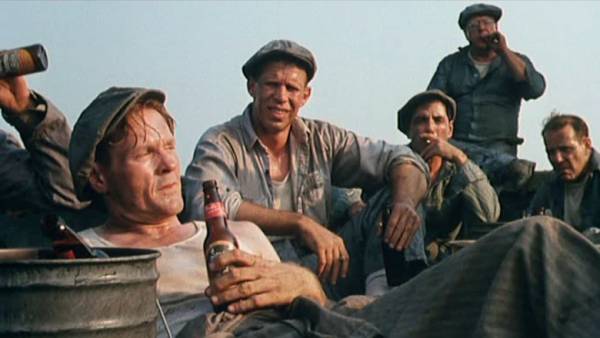Cocaine and forced labour: the hidden economy of American prisons
The prison industry in the United States — a multibillion-dollar economic system. Inside it has its own economy: in the absence of cash, prisoners improvising the different types of currency — from regular cigarettes and postage stamps to canned mackerel and instant noodles.

Every week on the day fixed for the life of the typical American prison is transformed: prisoners leave camera bags for bedding and back, tight stuffed them with food. Purchased by wire transfer chocolate bars, canned food and instant noodles prisoners are not in a hurry to eat — it becomes a local currency along with cash and cigarettes. Inside the US prison system has long existed its secret economy and the state makes millions of dollars on prisoners. “Ribbon.ru” versed in this complicated system of money and crime.
Familiar entertainment
The main engine of commodity relations in prison — of course, boredom. Usually in prison have nothing better to do — and pointless stretching term pushes convicts to find interesting pastime.
News Convicts goes through
Convicts goes through
Dull and dreary life of a prisoner often try to diversify through sports — most prisons are equipped with playgrounds for basketball, football and handball. Famous for Hollywood movies bars, horizontal bars and dumbbells are not in every prison — yard from the end of the 90s their number has significantly decreased due to budget cuts.
For those who do not see themselves in Amateur sports, is the reading usually pretty meager repertoire of the prison library — and, of course, television. TVs are usually several, and often they are assigned to a specific gang or group, so that the channel is switched without permission might provoke a fight. Most popular channels — again, those that broadcast sports matches.
In such a situation the vast majority of prisoners return to the usual ways of leisure. So for criminals is the use of drugs: according to statistics collected in five major U.S. cities, in the body from 63 to 83 percent of the detainees were found with psychoactive substance — usually marijuana and cocaine.
Hard for those who have been imprisoned by dependence on heroin or other opiates: in contrast to, say, diabetes, they don’t receive the necessary dose of the substance in the first days of stay in prison are doomed to a cruel breaking — panic attacks, severe body aches, vomiting and diarrhea.
On freedom for opiate addicts work centers where they provide free replacement therapy. In prison, their only conclusion is to endure the withdrawal syndrome and to expect the end of the period, surviving on minor amounts of a drug that does not penetrate from the outside in sufficient quantity and sold at a highly inflated price. Coming to freedom, from 40 to 60 percent of them return to drug use for the first few days. In most cases, they will soon again be under arrest — heroin addicts in 15 times more often than other people commit robberies, 20 burglaries, and 10 times more likely to steal.
Addicted to drugs behind bars appears and those who are not interested in them prior to the conclusion of: according to a study at Columbia University, about half a million American prisoners fit the medical criteria of dependence on alcohol and other drugs is about 65 percent of the prison population.
The news is a trading center that became a prison (photo)
is a trading center that became a prison (photo)
Another 458 thousand people at the time of the study was not drug addicts, although they have abused psychoactive substances. Together these two groups account for 85 percent of the total number convicted.
Only one-tenth of drug addicts falls into any rehabilitation program — most drugs for the entire period, keeping the relationship and after release from prison. It can not affect negatively on the crime statistics: the study of the Bureau of statistics under the Ministry of justice showed that one in four convicted of a violent crime at the time of its Commission was in an altered state of consciousness. To get behind bars can any drugs, but the price for the desired pleasure can be 10 times higher than at large — because of the difficulties of smuggling and consistently high demand.
With all amenities
The benefits available are secured the prisoners, of course, are not confined to drugs. In many prisons are permitted to order different goods through catalogues (including equipment). She, however, comes in a special transparent casing in which it is impossible to hide anything forbidden. Among prisoners are bought and sold all sorts of things and favors — from sneakers and the opportunity to sleep on the bottom bunk of a bunk bed to tattoos, sharpening, mobile phones, sexual services and even contract killings.

As there are commodity-money relations where prohibited money? Criminals find many other ways to establish economic ties, in addition to the banal exchange.
News American robbed a Bank to get into jail with a delicious meal
American robbed a Bank to get into jail with a delicious meal
Previously, the role of universal medium of exchange fulfilled the cigarettes, but in 2004 they were banned — and a variety of prison currency increased significantly. Now the money behind bars can replace a variety of products: sweets, instant coffee, and all sorts of household items that you can buy in the prison shop. Exchange rates vary from prison to prison.
In 2016 the American sociological Association published an article about prison currency is the result of an 18-month study of the life of one particular prison. The most popular medium of exchange in it was instant noodles. On conclusions of scientists, the convicts came to this because of the bad quality of prison food — those who work and play sports, just not enough calories.